
Illuminating! A Brief History of the Headlight

Today we’re going to take a look at a piece of automotive equipment that most people don’t give much thought to unless you’re blinded by them or forget to turn them on and get a freakin’ ticket. Headlights have been around for longer than automobiles (carriages used lights that were basically lanterns), but the vast increase in speed afforded by the auto meant that old technologies just wouldn’t cut it in the new order of things. Join us to explore how the headlight evolved into the high-tech device we know today.
Carbide (Acetylene) Lamps: 1880s to about 1900
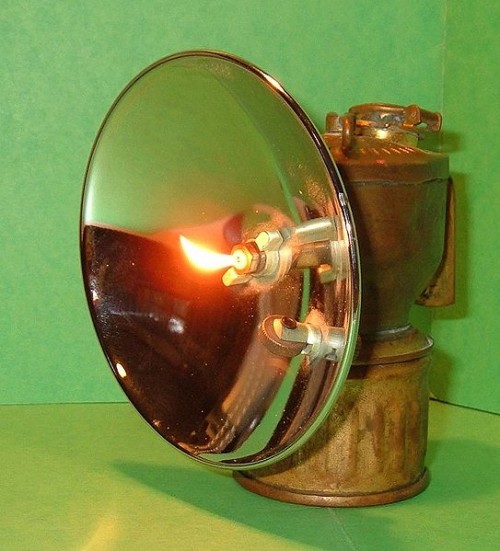
Carbide lamp showing flame and reflector.
The earliest headlight technology was essentially a lantern with a reflecting mirror. This focused the light source through an opening in the lantern, but because there were no effective headlight lenses at this time, the beam was fairly unfocused and there was a significant scattering of the light upwards as glare. This, combined with the low-candlepower light sources of the time, meant that they were a weak, low-speed-only means of illumination – unfocused and with poor range. Plus, a good gust of wind or a wayward splash of water could snuff the flame. The fuel was usually oil or the more weather-resistant acetylene. Acetylene lamps were also known as carbide lamps and had been developed for mining. Gas was produced by dripping water on calcium carbide, which produced the acetylene gas, which was then burnt in the lamp. However, the flame was sooty and the byproduct was caustic lime, a toxic substance that had to be disposed of. An improvement was badly needed …
Early Electric Lights: 1898
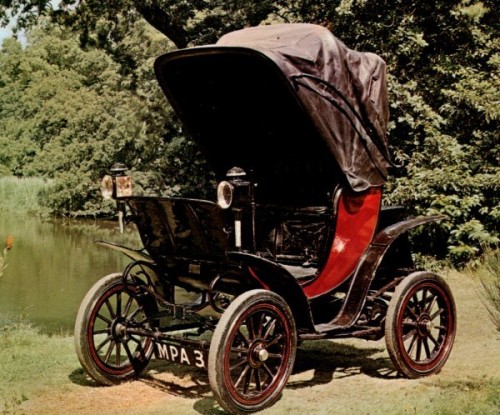
A Columbia Electric.
In the early days, when gasoline-powered cars were loud, dirty, and dangerous to start (before electric starters, the starter crank definitely could break your arm if you did it wrong), electric cars actually outsold them. So it’s probably no surprise that the first electric headlights debuted on an electric car, a Columbia. They weren’t necessarily an improvement right off the bat: they had weak tungsten filaments that often broke on the rough roads of the time. Soon they were adopted by gas vehicles, but at that point all gasoline-powered vehicles used dynamos rather than the alternators we know of today, and basically they produced a lot less electricity. The bottom line is that these headlights were dim and broke easily, and probably most importantly, still didn’t have a lens to focus their light. That innovation would come soon after.
Lens-Focused Headlight: the Corning Conaphore, ~1910s
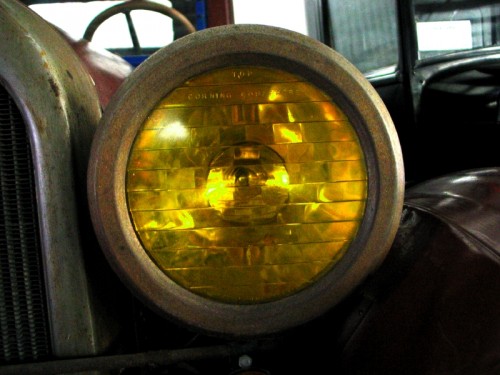
The Corning glass company of Corning, NY, debuted their revolutionary Conaphore headlight in the 1910s. Borrowing a page from lighthouses and other lens-focused light apparatus, the Conaphore was the first modern headlamp (other than an early attempt by Hella to use a lens technology on an acetylene headlight) because it used the lens to direct light from an electric bulb down and out in front of the car, allowing more of the available candlepower to illuminate the road. It was billed as a major safety innovation, eliminating accident-causing glare and increasing headlight range. How effective was it? It’s hard to say how it would compare to a modern headlight, but it was leaps and bounds above anything at the time. It was also the direct ancestor of all modern automotive lighting.
Hi/Low Beams: 1915-1917
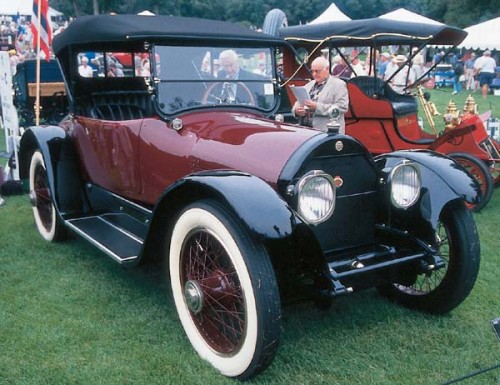
1917 Cadillac.
The next innovation was in the same vein as the Conaphore: a way to better direct light down to the road and away from other drivers’ eyes. The solution this time was a “dipping” light – a headlight that was physically moved to change the angle of the beam downwards. This reduced the range but also lowered the beam enough to not blind oncoming traffic. The first system, developed by the Guide Lamp Company in 1915, required the driver to physically get out of the car to set the lights to “low” beam. Cadillac improved on the system in 1917 with a lever in the car that did the same thing.
Two-Filament Hi/Low Beams: 1924 Hilux
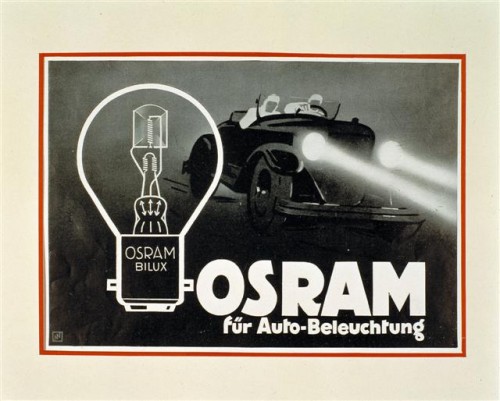
This system represented the hi/low beam setup we know today: two filaments in the same lamp, where the lamp stays in the same position physically and the switch merely affects the light’s output (wattage). This lead to the dimmer switch, initially a foot-operated one, but eventually the stalk-actuated dimmer that we’re most familiar with today.
Sealed Beam: 1940-1983
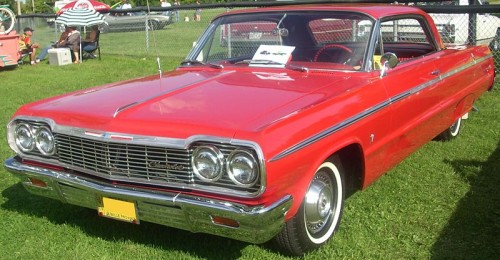
Chevrolet Impala showing quad sealed beam setup.
Anyone who’s worked on an American-market car from 1940 until the early 1990s knows about these guys. Much like a household flood light bulb, these one-piece lights combined the filament, reflector, housing, and lens, meaning that when it burned out, the whole thing needed replacement. They improved reliability somewhat because there was no way foreign matter could find its way into the lamp, possibly causing hot spots and early burnout, but mostly they were a method for the US government to ensure that all cars were using the same government-approved lights. Federal Motor Vehicle Safety Standard 108 required that all cars use a system of two 7″ round sealed beam headlight until 1970, when the Feds allowed rectangular headlights to sprout from some lucky vehicle fascias … mostly trucks. The big change happened in 1983, when composite headlights were allowed (but not required) to be utilized. It would be a few years before sealed beams would be phased out in almost all applications.
Composite Headlights: 1983-Present
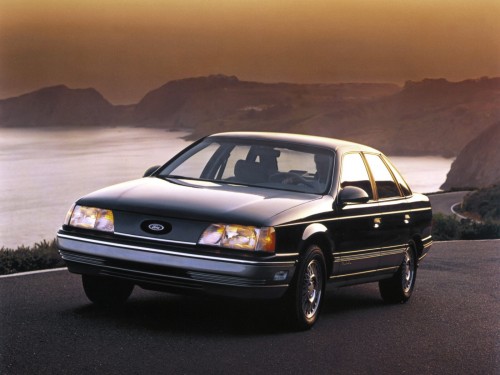
The famous Taurus composite headlights.
As noted above, headlight options were limited for US-market cars, but in Europe, there were all sorts of strangeness abounding. Glass-covered headlights, such as on the Jaguar E-type and the Citroen DS were common across the pond but taboo in the states. Then in 1983, Standard 108 was amended to allow what was called composite headlights. Instead of replacing the whole unit, all you had to do with a composite system was remove the bulb – the housing, lens, and reflectors were all permanent. The first US-market car to sport such a headlight assembly was the 1984 Lincoln Continental Mark VII, recently restyled as part of the first wave of “aero-” or “jellybean-designed” cars that you probably can best visualize in the first-generation Ford Taurus. This allowed all sorts of unique front end designs to promulgate and became the standard headlight type that you’re probably most familiar with.
Pop-Up Headlights: 1936-2004
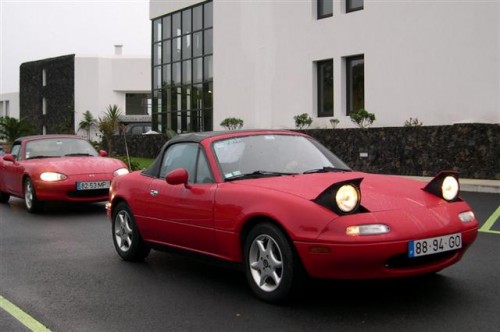
Mazda Miata showing pop-ups (with 7 inch sealed beam lights)
Starting with the ’36 Cord and ending only in 2004, when the Corvette was last produced with pop-up lights, this feature allowed for smooth, aerodynamic front ends and kept the lights clean when retracted. Of course, it added complexity and weight, needing motors or linkages to raise and lower the lights. In the 1960s, some cars were “required” to have them in order to meet US minimum-height laws for headlights. A majority of the reason that these lights have become less common is that European pedestrian safety regulations have rightly pegged a popped-up headlight as a hazard, and thus manufacturers have shied away from using them.
Halogen Bulbs
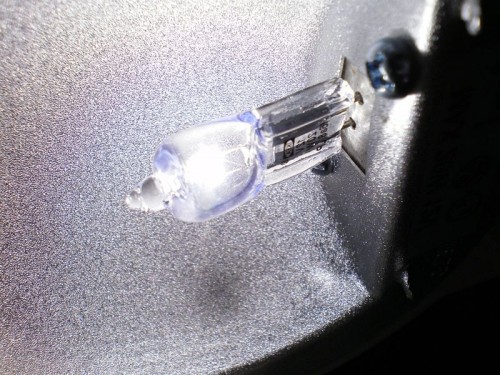
These could be more accurately called tungsten-halogen bulbs. As mentioned above, early electric headlights used tungsten filaments in a vacuum, which due to the properties of tungsten left the inside of the bulb blackened with residue. It was also not very efficient, needing a lot of power for a small amount of light. Enter then halogen lamp. Halogen is not a gas, it’s actually a group of gasses like chlorine and iodine. By combining a bit of one of these gasses with an inert filler gas, you can get a tungsten element to burn brighter with less energy … what’s not to like? Most modern headlights use halogen bulbs.
Projector Lens Headlights
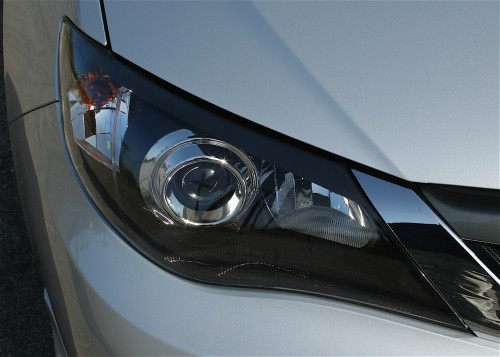
The domed lens of a projector light visible on a Subaru Impreza.
Also known as poly ellipsoidal lamps, these lights’ first use as the main standard headlight was on the 1986 BMW 7-Series. It places the bulb in the middle of a wine-glass shaped reflector. The light is focused into a convex lens, which then projects the light out into a very specifically defined pattern. A very sharp cutoff is achieved by blocking part of the light with an opaque shield, focusing more of the light down than in traditional lens lights. Some projector headlights switch between low and high beam by moving the shield, allowing for a higher cutoff. These are generally used in higher-end cars, notably BMW, Acura, and Mercedes-Benz.
High-Intensity Discharge (HID) Lights

A Lincoln showing HID lights.
The most recent revolution in headlight design is the high-intensity discharge, or “xenon,” lights. These are actually metal-halide arc lights, which use two tungsten electrodes to arc a powerful electric charge. This charge interacts with the gases inside and vaporizes metal salts present in the bulb, producing a plasma that emits very intense light. This is in contrast to a normal halogen bulb, which simply uses electricity to heat the filament until it is incandescent, emitting light. Temperatures inside an HID bulb can reach 2000 degrees F. Xenon gas has used the help the lamp warm up quickly and produce light, unlike argon-based arc lamps commonly used as streetlights, which would take far too long to work in an automotive setting. HID lights tend to have a unique color based on the different spectrum of light emitted by this different process; usually, it’s tinged blue. They are used in combination with projector lens headlamp assemblies to produce a very effective light at less power consumption than a normal halogen bulb. However, any contamination like dirt or dead bugs on the lens can cause a great deal of glare to be directed up and towards other motorists, and so care should be taken to keep HID lights clean to avoid blinding other drivers.
The Future: LEDs?
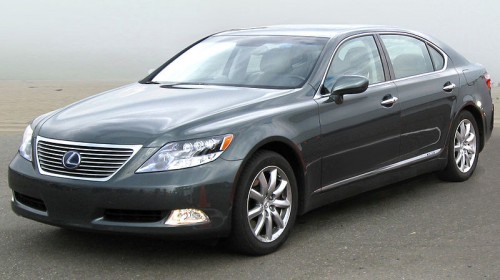
Lexus LS600, first LED headlight car.
Light-emitting diodes are the next big thing in automotive lighting. While currently expensive, LEDs offer several advantages. One of the most important is that they are low-heat producing, as they don’t heat up an element in order to produce light. However, there is heat produced from the back of the lamp, requiring complex and expensive heat sinks. That also means that in cold weather, you can’t count on an LED headlight to thaw ice or snow off of the headlight like you can with typical halogen or HID setups. They’re also temperature sensitive, giving different light levels at different ambient temperatures. Despite these engineering challenges, they give a reasonable performance with lower energy consumption. The Lexus LS was the first auto to employ LED headlights beginning in 2008, although they’ve been used as parking lights, taillights, and turn signals for a while. Will they become the premium headlight technology of the future? Only time will tell.
That’s it! Hope you’ve enjoyed this quick look into something that most people don’t pay much attention to … unless they’re burned out, that is.
